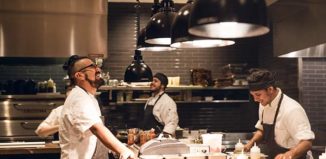Foam. Culinary foam. It’s the origin of molecular mixology, the love child of molecular gastronomy and extreme mixology. Foam is just the beginning.
There is a sect of alchemists, bar chefs who resemble scientists, who are mixing cocktails that more resemble potions than highballs, and whose professional pedigrees descend from a common ancestor: Ferran Adria Acosta, famed chef of the Michelin three-starred restaurant, El Bulli in Catalonia, Spain. He might be affectionately called the “Foam King.”
For every type of drinker-card-carrying foodies, certified “Top Chef” DVR-ers, and thirsty men and women willing to try anything once – there is a liquid yellow-brick road that will lead you to a magical molecular cocktail. It may be made with emulsifiers, immersion circulators or chilled to sub-zero temperatures with a tableside nitrous tank, creating an ice-cold cocktail that has not been diluted with water. (Hence the two-cocktail limit before you’re stripped of your car keys.)
The ideas for this fusion of kitchen, science and the “stick” (the vernacular for an old-fashioned long bar top) are the product of mixologists applying culinary and chemistry attributes to the art of the bar. These ideas are the creative Lincoln logs that build (or deconstruct) unheard-of drinks. The “cocktail” you experience may come in solid form, may be submerged in a gelatin cube or may be a full deconstruction of a classic cocktail.
Chefs who Inspired it: Ferran Adria Acosta, Wylie Dufresne
Buzz Words: Foam, emulsifier, agar, deconstructed, gastrique, bloom
Culinary Foam: A technique or ingredient made by using fruit, vegetable, or botanical juices or extracts, combining them with egg whites or agar (a fancy jelling agent) and pressing these ingredients through a whipped cream canister that’s locked and loaded with nitrous oxide.
The Mother Ship – Molecular Gastronomy: The application of science to culinary practices and cooking phenomena.
Caviar/Pearls: In the world of molecular mixology, a ball of gelatin custom flavored with a syrup, juice or other natural flavor, served with or alongside a cocktail, and technically made with sodium alginate and calcium chloride or with syrup and canola oil.
Blooming Caviar/Pearls: Made by placing gelatin powder or sheets in water until it gels and gets gummy.
Famous Bars Showcasing Molecular Mixology: wd-50, Manhattan; National 27, Chicago; Vessel, Seattle; NOPA, San Francisco; Barton G, Miami; Geronimo, Santa Fe
Gastro-mixology: Another word for chef-inspired mixology.
The Web Connect: http://blog.khymos.org
Xanthan Gum: Simply a better version of gelatin and cornstarch.
Godfathers of the Movement: Hervé This and Harold McGee
Things to Watch for: Gaseous clouds of smoke, gelatin solids in your liquid, foam foam foam, ice cubes, bruleed cocktails, cocktailian words you don’t recognize (and not just because of the number of cocktails you’ve ingested).
C.A.S.F.(Cool As S***Factor):100percent. If a bar has taken this much time to impress you and your taste buds, please take the time to take someone you want to impress to the bar.
Intoxication Index: This depends on the method d’employ, but these cocktails can be rated as “through the roof” on some people’s individual intoxication index- es. At Barton G in Miami, cocktails “chilled” tableside with nitrous tanks are not diluted by the traditional shaking with ice, so beware!
Bars in Austin where Molecular Experiments Occur: Fino, The Woodland, Starlite, Peacock Lounge, Four Seasons Hotel Austin, Hilton Austin Bar/Finn & Porter
RECIPES
How to make pearls/caviar without using sodium alginate and calcium chloride:
- Use a sheet or half sheet of gelatin, bloom it, take out of water and squeeze out excess moisture.
- Use liquids of your choice that you might want as a simple syrup, juice or liqueur, pour into pot, add gummy gelatin.
- Heat until gelatin dissolves (this will take only a few seconds).
- Chill mixture and place in squeeze bottle with tiny hole in tip.
- Simultaneously chill a small jar of canola oil until it is as cold as it can be without freezing.
- Squeeze thickened, gelatinous liquid out of bottle into extremely cold canola oil. Drops of liquid will coalesce and drop through the oil, forming pearls/caviar of designed flavor.
- Strain through sieve and capture pearls/caviar.
- Use caviar in cocktails, reuse and refrigerate oil until almost frozen.
APRIL IN PARIS
1/2 ounce Armagnac or Cognac
1/2 ounce Cointreau
1/2 ounce orange or tangerine juice
2 drops orange bitters
Top with Honey Blossom Foam and grated orange zest
HONEY BLOSSOM FOAM
4 egg whites
6 ounce water
4 ounce honey
2 ounce orange or tangerine juice
Place all into an iSi canister, charge and refrigerate



































